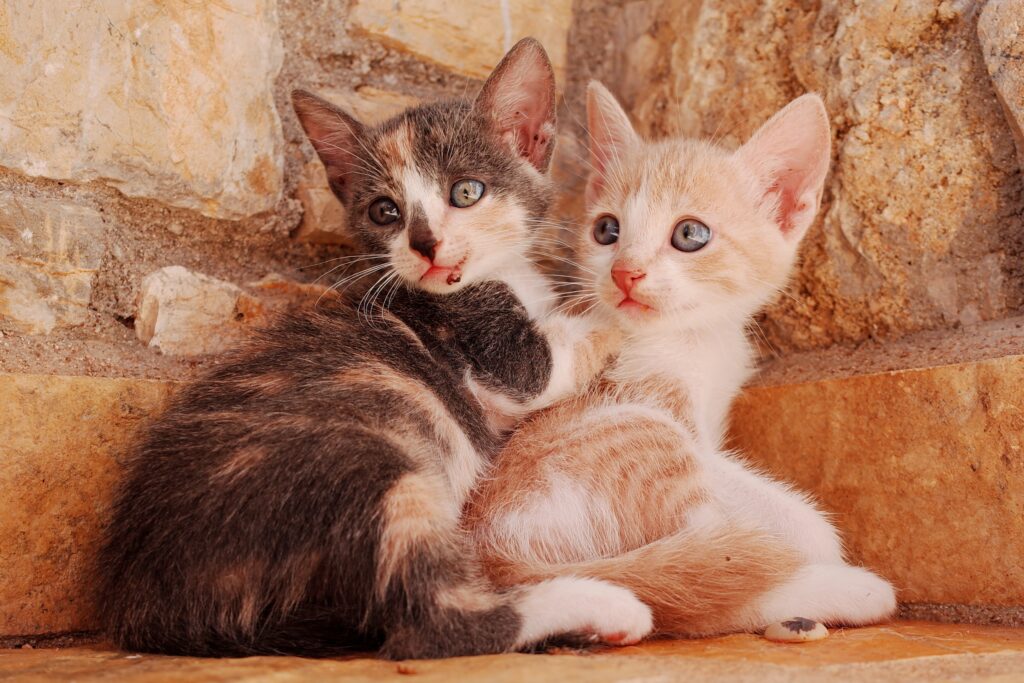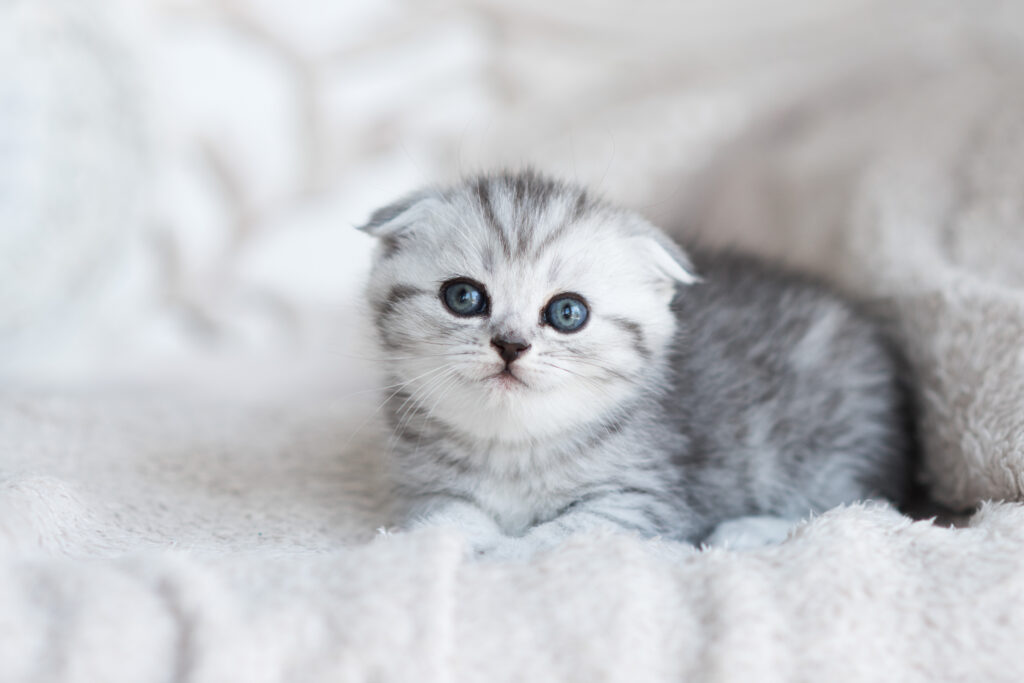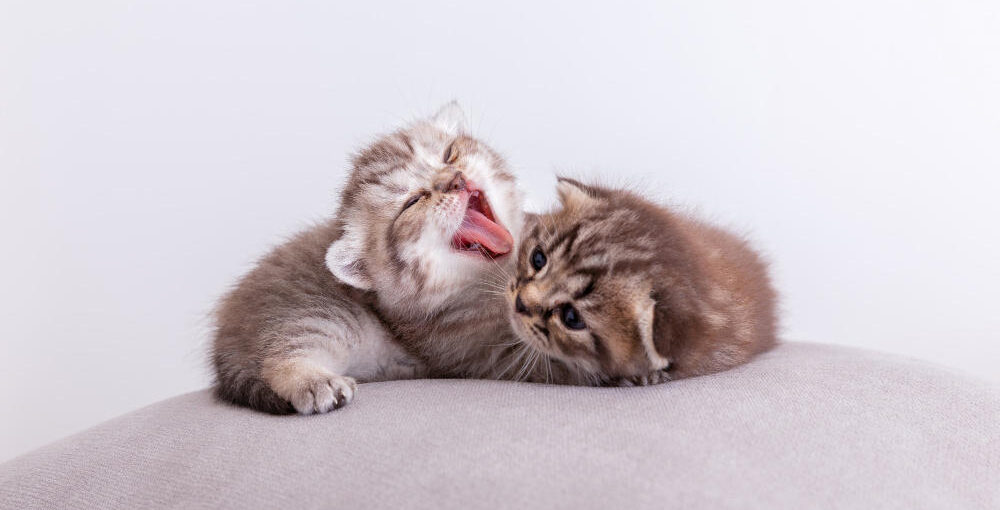Would you like to know how old a kitten is? Usually, you don’t need to find out for yourself, as both the association where you adopted the cat and the owner of the mother cat will in principle tell you the age of the kitten. However, if you have found or inherited a kitten, it can be very tricky to find out how old it is.
Why is it important to know the age of a kitten? Because cats grow so quickly, a four-week-old baby has very different needs from an eight-week-old kitten. If you’ve suddenly found a little ball of fur to look after, you need to be aware of its needs, especially if you can’t take it to the vet straight away.
Even if you know your new cat’s age (even their birthday!), it’s fascinating to learn about their developmental stages. We’ll show you the best ways to tell your cat’s age, followed by a typical developmental timeline.
How to tell the age of a kitten by its weight?
Knowing a cat’s age isn’t always easy for new owners, but often a kitten’s weight and size can seem like the obvious starting point. It’s not always the most reliable way to tell the age, as weight can vary depending on the breed, health and early life the kitten has had: a street cat won’t be as chubby as a pedigree with a well-fed mother.
However, we can always get a rough idea by comparing our kitten with the middleweights:
A newborn baby weighs about 100g
A healthy kitten then gains about seven grams every day. So by the end of the first week, we are expecting an increase to 150 grams
Week 1-2: 113-170g
Week 2-3: 170-225g
Week 4-5: 225-450g
Week 6-7: 450-680g
Week 7-8: 680-900g

How to tell the age of a kitten by its teeth
This is one of the best ways to know the age of a kitten. If it is a very small cat, looking at the teeth will tell you if it is less than or more than two weeks old. So, if you don’t have teeth, you’re less than a fortnight old, and if you do have teeth, you can brush up even more on your tooth knowledge here below.
Warning: these teeth may be tiny, but so are pins and needles….
How to tell the age of a kitten by its teeth? You need to know what happens and when. Here’s a guide to when teeth show:
Incisors. Milk teeth begin to appear at two to three weeks, and incisors are usually the first to appear
Canines. These start to show through the gums when the cat is three or four weeks old
Premolars. If you see them, the kitten is about four to six weeks old
Molars. We then have a big jump, as you won’t see them until the cat is about 16 weeks old.
A complete set of milk teeth is usually made up of
6 upper incisors
6 lower incisors
2 upper canines
2 lower canines
3 upper premolars
2 lower premolars
These begin to be replaced by adult teeth from the age of four months. Between the ages of four and seven months, the young cat replaces all its milk teeth and grows four new molars.
As you can see, teeth are a good way to tell a cat’s age, but it all becomes a little more inaccurate once they are past six weeks old. So we have to look for other clues to know the age of a kitten….
Other factors to know the age of a kitten
Now comes the real detective work: how to tell a cat’s age using other types of clues. So, Sherlock Holmes, what else do we need to watch out for?
Eyes: these open at 7-10 days. All cats have blue eyes at first and start to develop their adult shade at around 7 weeks.
Ears: this is another way to identify a baby, as their ears remain folded upwards until around 7 days old. However, they will not be fully deployed until a week later
Umbilical cord: must have dried up and fallen off during the first week. If you see a kitten with an umbilical cord, it is likely to be five days old or younger.
Sexual maturity: this is an important fact to know when it comes to spaying and neutering. Generally, a male cat announces his sexual maturity at around six months of age, when he begins to mark his territory. A cat matures between the ages of five and nine months

The Chronology of a Kitten
Let’s take a quick walk through the early development of a typical kitten. Not all cats follow the same timeline and yours may be early or slightly late. If in doubt, talk to your vet.
Newborn: a newborn baby cannot open its eyes and has its ears unfolded. He feeds every two hours and spends the rest of the time sleeping. At the end of this period, it starts to move little by little.
One week: eyes should start to open at around seven days, although they cannot yet focus. His ears are now starting to show, which is very cute. He continues to eat every two hours and his mother encourages him to go to the toilet.
Two weeks: the kitten is kneading and trying to stand up, a bit wobbly. You’re starting to develop your sense of smell and become more aware of what (and who) is around you, which can lead to some lovely moments! Feeding is now done every 3-4 hours.
Three weeks: a lot happens this week. The kitten is starting to get its milk teeth, and (bring on the drums) you should be able to play them by now. They are more steady on their paws and starting to play together a bit. Feeding is done 4 to 5 times per hour.
Four weeks: the kitten is now playful, quite robust and starting to look super cute. At this age, the kitten can begin to be trained to use the litter box. Baby’s canine teeth are emerging, a sign that he is getting ready to try food…. Milk feeds are every five hours and longer.
Five weeks: the molars are coming in, which means it may be time to eat solid food. Play is now more important than sleep (especially when they have just eaten and are full of energy). Humans need to handle them a lot for them to socialize.
Six weeks: a healthy kitten should now be playful, enjoy solid food and generally love life. It is a very important time for their development, so they should continue to play and be handled. The kitten can now use its tail to balance itself and is starting to get much braver….
Seven weeks: the kitten is almost fully weaned and wants to explore more of its surroundings. He has all his milk teeth and his true eye color is starting to develop.
Eight weeks: this is a truly remarkable week. The kitten is completely weaned from its mother and begins to eat fresh food and water. From now on, you can leave mom and go to her new home.
Nine weeks: the rate of growth is starting to slow down, but their skills are developing literally by leaps and bounds and they are beginning to form real bonds with their guardians.
10-12 weeks: the cat is independent, confident and spends a lot of time honing its hunting skills and exploring its world.
12-14 weeks: start ranking the house in terms of who’s the best cat (hopefully it’s you, but as you’re competing with a cat, that may not be the case!).

